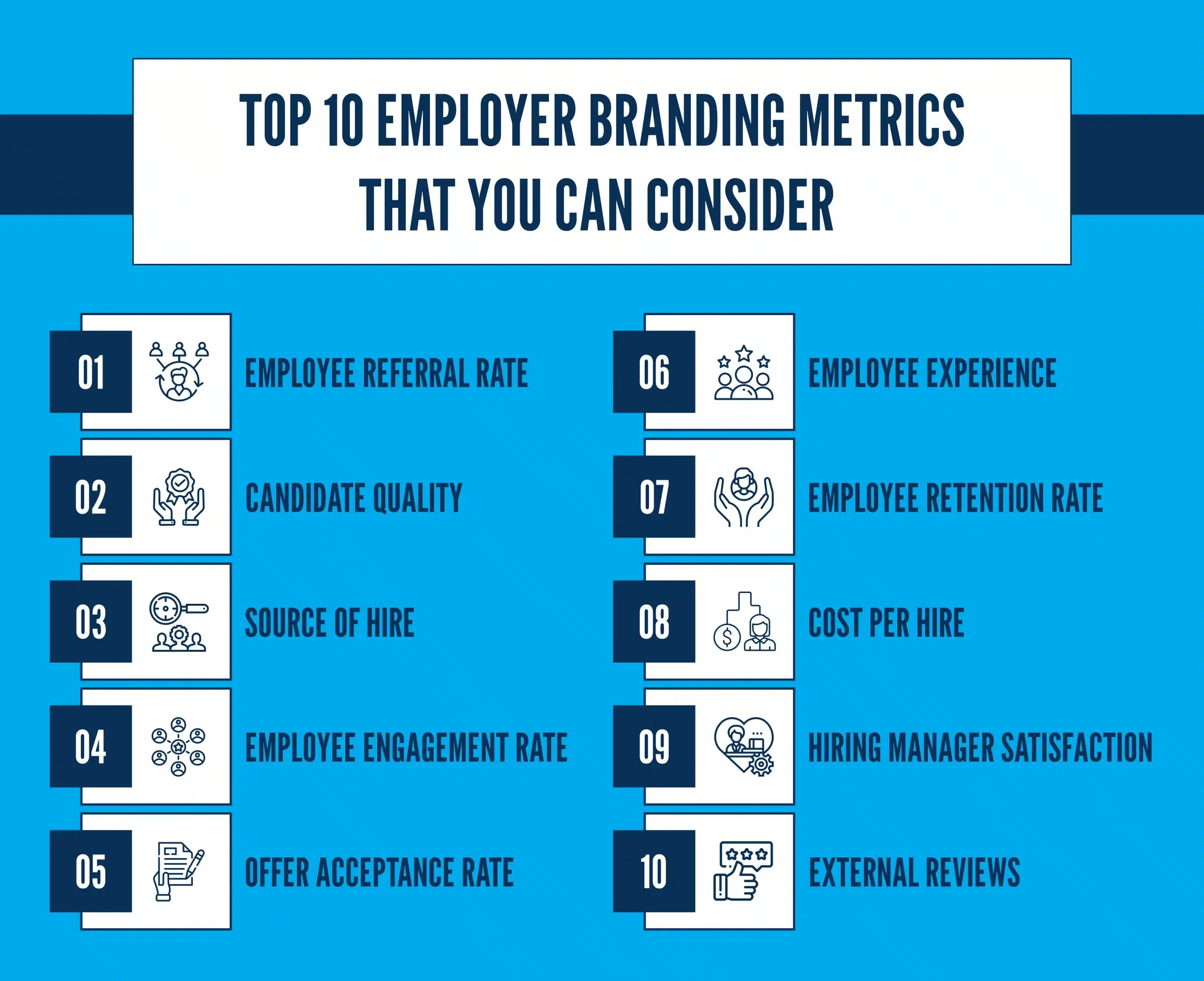Table of content
However, hiring and retaining top professionals can be daunting when competing in a highly crowded market. There are multiple factors that candidates take into consideration while applying for a job, and if you want to attract such candidates, you’ll need to keep your position strong on those factors.
According to a study conducted by LinkedIn, one such factor is employer branding. The report suggests that 75% of candidates closely analyze employer branding before applying for the position. Employer branding affects not only the recruitment process but also the retention of existing employees.
In this blog, we will walk you through the employer branding metrics to help you understand the current position of your brand and the areas where you can improve. So, without any further ado, let’s get started!
What is Employer Branding Metrics?
Employer branding metrics are a set of data-driven insights that can help you understand your ideal candidate’s preferences, behaviors, and attitudes toward your brand. By collecting and analyzing this information, you can tailor your employer branding efforts to better resonate with current and potential employees.
It can measure and track various factors, including employee satisfaction, candidate engagement, brand awareness, social media presence, and more. By using these metrics, you can better understand your brand’s position on the market and make better decisions about the messages and communications you use to attract and retain top talent.
Looking at employer branding examples can offer insights into ideal candidate preferences and research habits, enabling businesses to create targeted campaigns that resonate with their audience.
Top 10 Employer Branding Metrics That You Can Consider
Building a strong employer brand is important to attract and retain top talents in today’s competitive job market. But how do you measure the effectiveness of your employer’s branding efforts? Here are the top 10 employer branding metrics that you can consider:
Employee referral rate
The employee referral rate is an important metric for measuring the success of your employee referral program. It shows the percentage of job candidates who come from employee referrals. Studying this metric can help you understand whether your employees are happy with your organization. A high employee referral rate indicates that your employees are engaged and dedicated to your organization, which can lead to smoother recruitment and retention outcomes.
Candidate Quality
Assessing candidate quality is crucial in attracting top talent. Studies show that a strong employer brand can increase qualified applicants by up to 50%, leading to better engagement, retention, and recruitment outcomes. Investing in employer branding can help businesses stand out from competitors, attract high-quality candidates, and improve reputation and employee satisfaction.
Source of Hire
The source of hire is one of the crucial employer branding metrics that plays a significant role in helping recruiters determine their effectiveness in hiring and identifying successful sourcing channels. Measuring the source of hire involves analyzing the primary sources from where most hires are made and evaluating whether the resources are allocated effectively. By measuring the source of hire, recruiters can make better decisions about where to target and allocate resources, optimize their recruiting efforts, and improve the effectiveness of their employer branding strategy.
Employee engagement rate
The Employee engagement rate is an important metric that can be used to determine the effectiveness of an organization’s employer branding strategy. It measures employees’ satisfaction and motivation towards their work and the company they work for. Happy and satisfied employees are more likely to promote their organization as a great workplace, which can attract top talent and improve the company’s reputation.
Offer Acceptance Rate
The offer acceptance rate is a critical employer branding metric for any organization that wants to attract and hire top talent. This metric measures the likelihood that a candidate will accept a job offer that has been extended to them. A high acceptance rate indicates that your recruitment marketing and employer branding are effective and resonate well with potential hires. It indicates that candidates perceive your organization as a desirable workplace and are excited about the opportunity to join your team.
Employee Experience
Employee experience is the overall journey of an employee while working at an organization. Measuring and improving it is crucial to building a strong employer brand on the market. Companies analyze insights from employee surveys and exit interviews to get feedback on employee experience, identifying areas of improvement to create a positive and engaging work environment.
Employee Retention Rate
Employee Retention Rate refers to the percentage of employees who stay in a company over a certain period of time. It is a crucial metric for building a stable and productive workforce. High employee retention rates indicate a healthy work culture and are essential for reducing recruitment costs and maintaining institutional knowledge. Companies prioritizing employee retention focus on building a positive work environment, offering competitive compensation and benefits, providing opportunities for growth and development, and recognizing employee contributions.
Cost per Hire
Cost per Hire is another vital employer branding metric for organizations looking to hire top talent cost-effectively. Organizations that invest in building a strong employer brand tend to have lower costs per hire. With more quality candidates coming to them, recruiters can spend less time and money on sourcing ideal people for open roles. By optimizing the cost per hire, companies can cost-effectively attract and retain top talent, reducing recruitment costs and building a productive and engaged workforce.
Hiring Manager satisfaction
Hiring Manager satisfaction is a metric that helps organizations measure the success of their employee branding program. One of the best ways to measure this is to gather feedback from hiring managers about their satisfaction with the candidate selection process. Measuring hiring manager satisfaction helps determine whether or not the organization is attracting the right candidates and how well they fit the company culture. One effective way to gather this feedback is through surveys asking hiring managers about their satisfaction levels with the recruited candidates.
External Reviews
External reviews are a valuable tool to enhance your employer branding strategy and attract top talent. Websites like Glassdoor, Comparably, and Indeed provide overall company ratings, CEO approval ratings, and employee reviews. They help you understand your employees’ perceptions, identify areas for improvement, and create a positive image of your company. Regularly monitoring and responding to these reviews is essential to accurately reflect your company’s values and culture.
Conclusion – How You Can Implement Employer Branding Metrics
Building a strong employer brand on the market is vital for attracting top candidates and building a positive reputation for your organization. To achieve this, it’s important to implement employer branding metrics and measure your brand perception and engagement. This can be done through employee satisfaction surveys, social media analytics, and candidate feedback. By analyzing this data, you can identify areas for improvement and make necessary changes to your branding strategy. Continuously evaluating and refining your strategies based on collected data will help you maintain a competitive edge in the market and establish your company as an attractive and desirable place to work.





